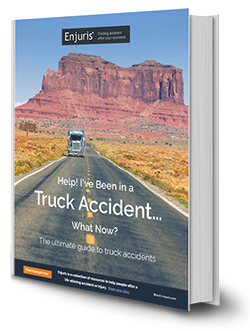A guide to big rig accidents and how they differ from car accidents in the Buckeye State
Big rigs are big business in the Buckeye State. In fact, Ohio's trucking industry is the 4th largest in the nation. Almost 80% of goods shipped from Ohio to other states travel solely by truck.
What's more, Ohio has the 7th largest road system in the country, consisting of almost 123,000 miles.
All of this means that, whether they occur on I-75 running from Cincinnati to Toledo or the country roads snaking through Washington County, truck accidents are inevitable.
When a large truck crashes, the damages are often significant.
In this article, we'll take a look at truck accidents in the Buckeye State, including who's liable, how you can recover damages, and what to look for in a personal injury attorney.
Truck accident statistics
According to the Centers for Disease Control and Prevention (CDC), more than 1 in 3 long-haul truck drivers have experienced a serious truck crash during their career. In 2018 alone, there were just over 450,000 police-reported crashes involving large trucks in the United States.
When trucks collide with passenger vehicles, it's generally the passenger vehicle occupants who suffer serious or fatal injuries. This is because large trucks often weigh 20-30 times as much as passenger cars.
In fact, of the 4,136 people killed in large truck accidents across the US in 2018, only 16% were large truck occupants.
In Ohio, 565 people were killed in large truck accidents from 2014 to 2018.
| Ohio truck crash fatalities (2014-2018) | ||||
|---|---|---|---|---|
| 2014 | 2015 | 2016 | 2017 | 2018 |
| 102 | 132 | 92 | 118 | 121 |
Source: Ohio State Highway Patrol
Ohio trucking laws
Large trucks have to follow the rules of the road just like everyone else. But federal laws also establish additional standards that trucking companies and drivers must meet. These standards can be found in Title 49 of the Code of Federal Regulations and cover everything from drug testing to load restrictions.
One of the most important federal laws is the law regulating the number of hours commercial drivers are permitted to drive. This law was passed to help reduce the number of accidents caused by driver fatigue.
| Hours-of-service limitations for commercial drivers | ||
|---|---|---|
| Work | Property-carrying vehicles | Passenger-carrying vehicles |
| On-duty | Maximum 14 consecutive hours on-duty following 10 consecutive hours off-duty | Maximum 15 hours on-duty following 8 consecutive hours off-duty |
| Driving time | Maximum 11 hours of driving during the 14-hour on-duty period | Maximum 10 hours of driving following 8 consecutive hours off-duty |
| Weekly | Maximum 60 hours on-duty in any period of 7 consecutive days (if the vehicle operates every day) or maximum 70 hours on-duty in any period of 8 consecutive days (if the vehicle doesn’t operate every day) | Maximum 60 hours on-duty in any period of 7 consecutive days (if the vehicle operates every day) or maximum 70 hours on-duty in any period of 8 consecutive days (if the vehicle doesn’t operate every day) |
Federal laws also enable the Federal Motor Carrier Safety Administration (FMCSA) to issue imminent hazard orders to prevent certain commercial truck drivers from operating commercial vehicles.
Failure to comply with an FMCSA imminent hazard order can result in significant civil and criminal penalties.
In addition to federal law, Ohio has its own laws that are intended to keep truck drivers and other motorists safe. These laws can be found in Title 45 of the Ohio Revised Code and cover things like:
- Maximum load weights
- Axle weight guidelines
- Speed limits
- Splash guards and other equipment requirements
Common causes of truck accidents
The FMCSA investigated the causes of large-truck accidents over a 5-year period and found that they could generally be broken down as follows (in order of most to least common):
- Decision (38%): The driver was driving too fast for conditions, misjudged the speed of other vehicles, or followed other vehicles too closely.
- Recognition (28%): The driver was inattentive, was distracted by something inside or outside the vehicle or failed to observe the situation adequately for some other reason.
- Non-performance (12%): The driver fell asleep, was disabled by a heart attack or seizure, or was physically impaired for another reason.
- Vehicle (10%): Vehicle failures, such as brake problems.
- Performance (9%): The driver panicked, overcompensated, or exercised poor directional control.
- Environment (3%): Fog, heavy rain, bad weather or roadway problems.
Who's at fault in an Ohio truck accident?
In truck accident cases, determining who's at fault usually means determining who was negligent (i.e., who failed to exercise reasonable care). Often the truck driver is negligent, but not always. Others who could be at fault for a truck accident include:
- The trucking company. The trucking company may be found at fault (or partially at fault) if they violated one of the federal or state laws (such as requiring the truck operator to drive for a longer period than permitted).
- The cargo company. One common cause of truck accidents is overloaded or improperly loaded cargo. In these situations, the cargo company may be at fault.
- The manufacturer. Truck accidents may be caused by a defective part or vehicle (such as an improperly designed trailer hitch that causes the trailer to come loose). In these situations, the manufacturer of the defective product might be at fault.
What if you're a truck driver and you were injured in a truck accident?
In most cases, truck drivers can file workers' compensation claims. Workers' compensation is a form of insurance that pays medical expenses and lost wages to employees who are injured while doing their job.
Ohio workers' compensation pays medical expenses, wage loss benefits, and death benefits for certain family members.
Shared liability laws
Sometimes, both the truck driver (or other party associated with the truck) and the motorist involved in the collision are at fault.
Under Ohio's modified comparative fault theory, the amount of damages a plaintiff can recover is reduced by a percentage that reflects the plaintiff's degree of fault. However, if the plaintiff's degree of fault is 51% or more, they are prohibited from recovering any damages.
Let's look at an example:
John was driving a tractor-trailer on I-75 through Dayton. He failed to properly secure the load and, as a result, some items fell onto the road. John instinctually slammed on his brakes when he saw the items fall.
Maria was driving behind John. Even though it was foggy, she was following John closely and was unable to stop before crashing into the back of John's truck. Maria suffered serious whiplash in the accident and sued John for $100,000.
The court found that John was 50% at fault for the accident because he failed to secure his load. The court also found that Maria was 50% at fault for the accident because she violated Ohio Code 4511.21, which requires drivers to maintain enough distance between them and the vehicle in front of them so they can stop without rear-ending the vehicle.
In this example, Maria would only be able to recover $50,000 (her total damages reduced by 50%). Notably, if Maria had been found 51% at fault for the accident (just 1 more percent), she wouldn't have been able to recover any damages whatsoever.
Truck accident damages in Ohio
Trucks can legally weigh up to 80,000 pounds. When a truck and a passenger car collide, there are bound to be serious injuries.
Some of the most common truck accident injuries include:
- Back and neck injuries
- Broken bones
Economic damages are tangible losses that come with a price tag (medical bills, property damages, lost wages, etc.). Non-economic damages refer to losses that don't have a clear dollar value (pain and suffering, loss of consortium, etc.).
If a loved one is killed in a truck accident, certain family members can recover damages associated with the loss by filing a wrongful death lawsuit.
Do I need an attorney for my truck accident case?
Trucking cases tend to be more complicated than regular motor vehicle cases for 3 reasons:
- The damages are often higher.
- The case often implicates federal and state laws.
- Several parties (including large companies with lots of money to spend on defense attorneys) may be liable.
Because of the unique challenges involved in litigating a truck accident, it's important to hire an attorney who has experience litigating truck accidents.
Once you've identified an attorney who has the right credentials and experience, you should schedule an initial consultation. Initial consultations are generally free, and they provide you with an opportunity to find out if the attorney is right for you and your case.
To make the most out of your initial consultation, come prepared to answer questions about your accident and ask the attorney the right questions to find out if they're a good fit:

A worksheet to prepare for your first meeting with a personal injury attorney – what to bring, what they'll ask
Download in PDF format

Worksheet with questions to ask a personal injury attorney to help determine if he or she will be a good fit for your case
Download in PDF format
Did you know that truck accident law varies by state?
Need a lawyer?
What does an injury lawyer do?
A personal injury lawyer helps individuals who have sustained injuries in accidents to recover financial compensation. These funds are often needed to pay for medical treatment, make up for lost wages and provide compensation for injuries suffered. Sometimes a case that seems simple at first may become more complicated. In these cases, consider hiring an experienced personal injury lawyer. Read more














